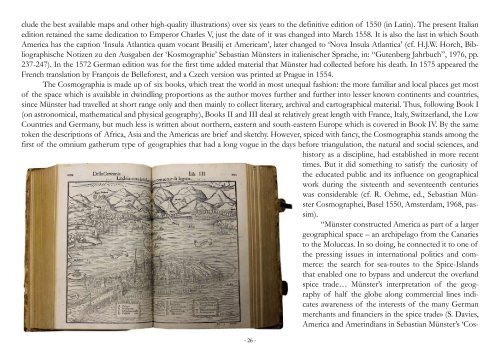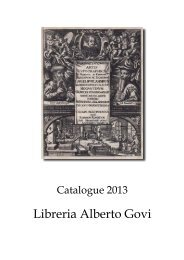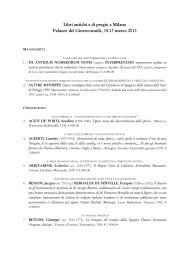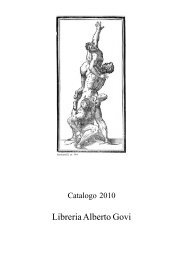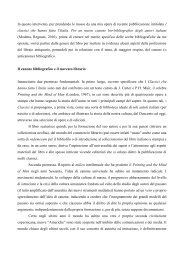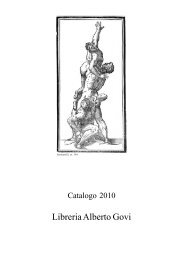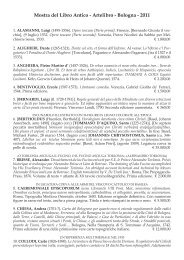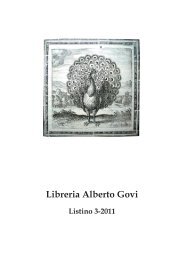List 4-2013 - Libreria Antiquaria Alberto Govi
List 4-2013 - Libreria Antiquaria Alberto Govi
List 4-2013 - Libreria Antiquaria Alberto Govi
Create successful ePaper yourself
Turn your PDF publications into a flip-book with our unique Google optimized e-Paper software.
clude the best available maps and other high-quality illustrations) over six years to the definitive edition of 1550 (in Latin). The present Italian<br />
edition retained the same dedication to Emperor Charles V, just the date of it was changed into March 1558. It is also the last in which South<br />
America has the caption ‘Insula Atlantica quam vocant Brasilij et Americam’, later changed to ‘Nova Insula Atlantica’ (cf. H.J.W. Horch, Bibliographische<br />
Notizen zu den Ausgaben der ‘Kosmographie’ Sebastian Münsters in italienischer Sprache, in: “Gutenberg Jahrbuch”, 1976, pp.<br />
237-247). In the 1572 German edition was for the first time added material that Münster had collected before his death. In 1575 appeared the<br />
French translation by François de Belleforest, and a Czech version was printed at Prague in 1554.<br />
The Cosmographia is made up of six books, which treat the world in most unequal fashion: the more familiar and local places get most<br />
of the space which is available in dwindling proportions as the author moves further and further into lesser known continents and countries,<br />
since Münster had travelled at short range only and then mainly to collect literary, archival and cartographical material. Thus, following Book I<br />
(on astronomical, mathematical and physical geography), Books II and III deal at relatively great length with France, Italy, Switzerland, the Low<br />
Countries and Germany, but much less is written about northern, eastern and south-eastern Europe which is covered in Book IV. By the same<br />
token the descriptions of Africa, Asia and the Americas are brief and sketchy. However, spiced with fancy, the Cosmographia stands among the<br />
first of the omnium gatherum type of geographies that had a long vogue in the days before triangulation, the natural and social sciences, and<br />
history as a discipline, had established in more recent<br />
times. But it did something to satisfy the curiosity of<br />
the educated public and its influence on geographical<br />
work during the sixteenth and seventeenth centuries<br />
was considerable (cf. R. Oehme, ed., Sebastian Münster<br />
Cosmographei, Basel 1550, Amsterdam, 1968, passim).<br />
“Münster constructed America as part of a larger<br />
geographical space – an archipelago from the Canaries<br />
to the Moluccas. In so doing, he connected it to one of<br />
the pressing issues in international politics and commerce:<br />
the search for sea-routes to the Spice-Islands<br />
that enabled one to bypass and undercut the overland<br />
spice trade… Münster’s interpretation of the geography<br />
of half the globe along commercial lines indicates<br />
awareness of the interests of the many German<br />
merchants and financiers in the spice trade» (S. Davies,<br />
America and Amerindians in Sebastian Münster’s ‘Cos-<br />
- 26 -


